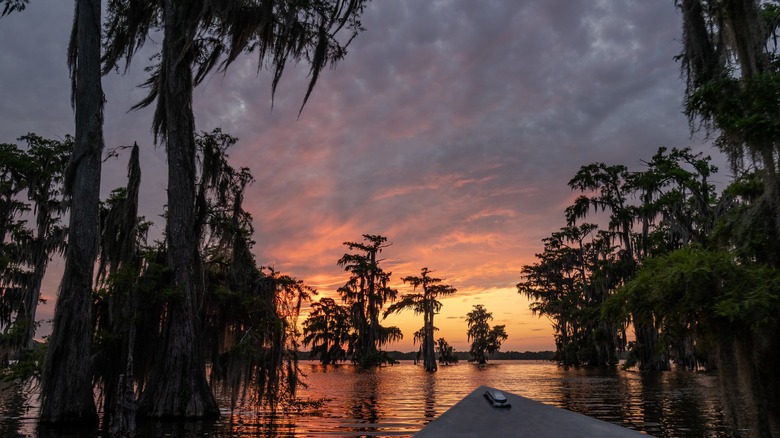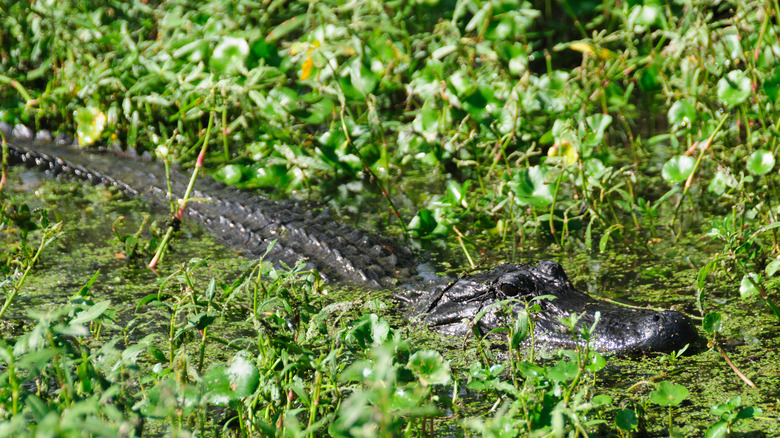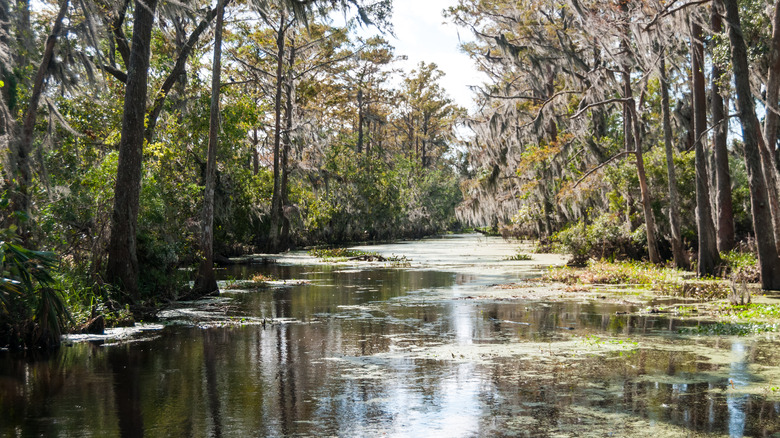One Of America's Largest Swamp Forests Is A Vulnerable Louisiana Beauty For Endless Recreation
When you think of Louisiana, your first thought might be the vibrant city of New Orleans and the famed Bourbon Street, the adult playground with countless bars and restaurants. The Pelican State is also renowned for its delicious Cajun cuisine and is the birthplace of America's legendary Tabasco hot sauce. Besides its fun atmosphere and food, Louisiana is also known as the "Bayou State" for its gorgeous marshes and wetlands. The Maurepas Swamp Wildlife Management Area is the most iconic but, at the same time, remains precarious.
The Maurepas Swamp is a 176-square-mile wetland 26 miles west of New Orleans, bordering Maurepas Lake, a 93-square-mile brackish estuary. It's a quintessential Louisiana landscape, home to water tupelo trees and bald cypress covered in sweeping Spanish moss, alligators lurking in the marsh waiting for their prey, and migratory bird species feeding on caterpillars and resting before embarking on their long journey to their breeding grounds. The swamp is known as a "sportsman's paradise," popular for hunting, fishing, and kayaking. It's also a birdwatcher's dream, where you can get glimpses of bald eagles, ospreys, pink spoonbills, warblers, and Northern Parulas. However, the existence of this biodiverse paradise has been under threat for the last century.
The project to revitalize the Maurepas Swamp
The Maurepas Swamp hasn't been thriving since the clear-cutting of bald cypress trees for building materials in the early 1900s, destroying the forest. Decades later, the building of levees on the Mississippi River to prevent flooding cut off the swamp's freshwater supply, further deteriorating its vitality. The ongoing negative impacts of global warming are destroying habitats and food sources, which continue to wreak havoc on this delicate and unique ecosystem. Furthermore, since the swamp acts as a vital buffer to the Greater New Orleans and Greater Baton Rouge areas during hurricanes, the degradation of the swamp imperils human lives, too.
Fortunately, a recent collaboration between different government agencies and NGOs launched the River Reintroduction into Maurepas Swamp Project, which aims to revitalize the precious wetland. More sediments and nutrients will enter by diverting freshwater into the swamp, converting it to marshes, decreasing its salinity, and improving water hydrology. This will not only prevent additional loss of wetland; it will enhance tree health and the wildlife habitats, allowing hundreds of species of reptiles, vertebrates, plants, and other animals to thrive. It also means that human residents and visitors can enjoy the wetlands for many more generations.
The best way to experience the swamp
A kayak tour, rather than a motorboat tour, is a less polluting and more active way to experience the Maurepas Swamp. You can get up close and personal with the swamp's infamous resident: the alligator! In the past, poachers hunted these ferocious creatures for their coveted skin. Since the 1960s, they have been protected under the law and are now thriving. They can be as long as 15 feet, and their bite is equal to having a small car (with sharp teeth) dropped on you. But fear not: They are unlikely to attack humans unprovoked and would prefer to leave us alone. One tour in the area is the Louisiana Cypress Swamp Photography Tour. It's a two-to-four-hour tour focusing on capturing the magical swamp with your camera lens. Typically, the tour starts right before sunrise or sunset. It's the best option if you're a budding photographer and want to capture the beauty of the wetlands.
The best time to visit the swamp depends on the season. In the summer, when the daytime weather is sticky and uncomfortable, the best time is at the coolest part of the day — at sunrise or dusk — when the wildlife is the most active. The beginning and end of the day also offer the softest light, which is best for taking photos. In the cooler winter months, it's ideal to visit in the middle of the day when it's the warmest for your best chance at spotting wildlife. Regardless of when you visit, wear comfortable clothing and mosquito repellent. Check out the coastal town of Grand Isle for more swamp adventures in Louisiana.


